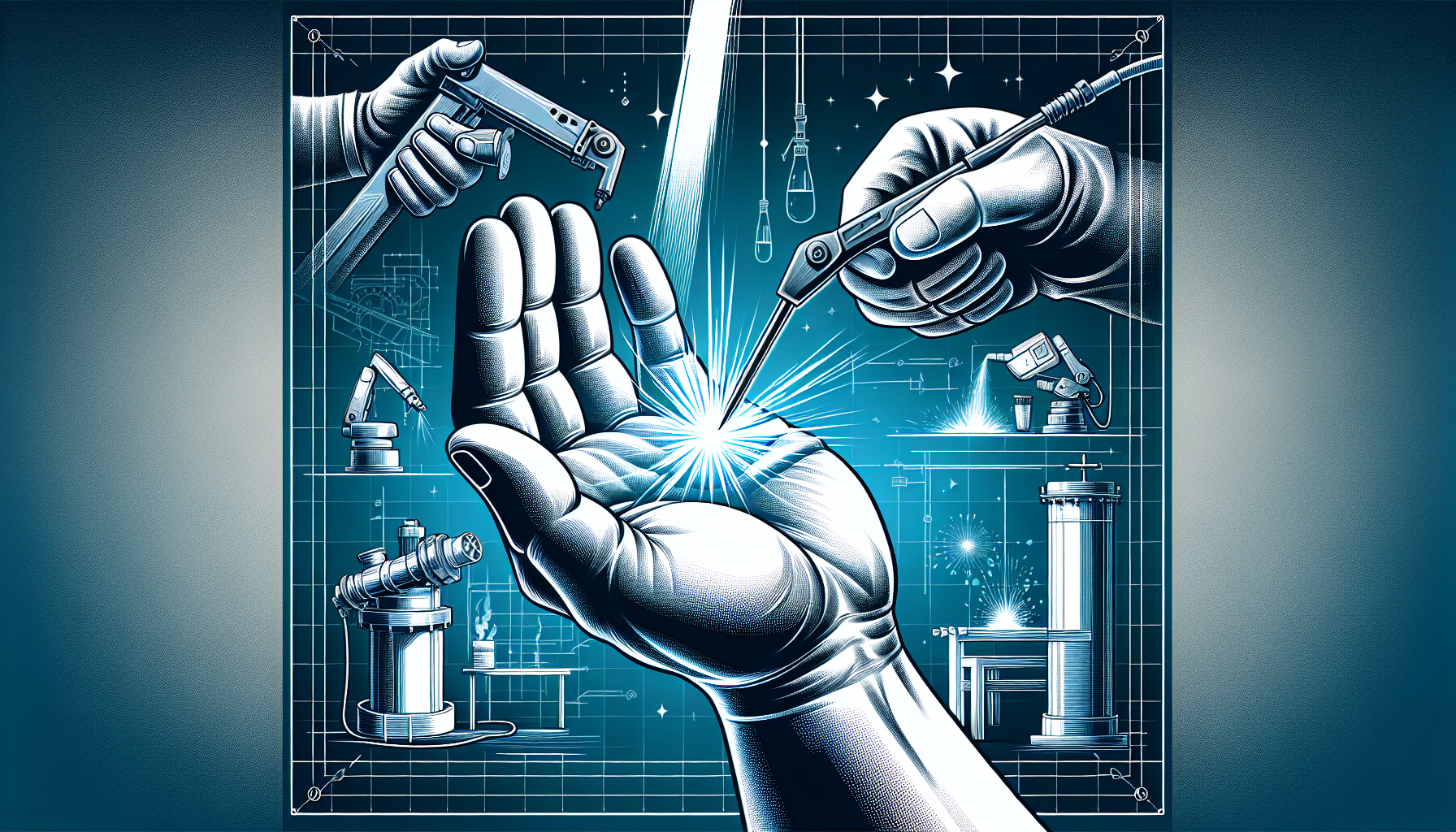Introduction

Achieving spotless welds is a critical aspect of maintaining the integrity and appearance of welded materials. Utilizing high-quality welding equipment and supplies directly impacts the effectiveness of weld cleaning. This guide will explore different weld cleaning methods, emphasizing the importance of using superior welding equipment for optimum results.
Why Proper Post-Weld Cleaning Matters
Post-weld cleaning is an essential step in the welding process that directly impacts the quality and longevity of the final product. Understanding the importance of proper post-weld cleaning is crucial for achieving spotless welds. The following factors highlight the significance of thorough weld cleaning:
- Preventing stainless corrosion: Inadequate cleaning can lead to the formation of corrosive elements on the surface of stainless steel, causing the material to deteriorate over time. Proper post-weld cleaning helps prevent corrosion by removing contaminants and ensuring the stainless steel remains in optimal condition.
- Ensuring weld passivation: Passivation is the process of forming a protective oxide layer on the surface of stainless steel, which reduces the risk of corrosion. Post-weld cleaning plays a vital role in ensuring weld passivation by removing any debris or surface contaminants that might interfere with the formation of the oxide layer.
- Meeting industry standards and regulations: Many industries have stringent requirements and regulations regarding the quality of welds and the cleanliness of the final product. Proper post-weld cleaning ensures that welded materials meet these standards and adhere to the necessary regulations, avoiding potential penalties or product recalls.
- Improving the appearance of the weld: A clean, spotless weld not only demonstrates the quality of the workmanship but also enhances the overall appearance of the final product. Proper post-weld cleaning helps remove any unsightly residue, discoloration, or debris, resulting in a polished and professional-looking finish.
By prioritizing proper post-weld cleaning, welders can ensure the longevity, durability, and appearance of their work, all while adhering to industry standards and regulations.
Common Weld Cleaning Methods
There are several methods for cleaning welds, each with its own advantages and drawbacks. Choosing the right method depends on factors such as material type, industry requirements, and available equipment. This section will explore the four common weld cleaning methods: mechanical, chemical, electrochemical, and electropolishing.
Mechanical Weld Cleaning
Mechanical weld cleaning involves the use of abrasives, such as grinding wheels, wire brushes, or sandpaper, to remove contaminants and excess material from the weld surface. This method is simple and relatively inexpensive; however, it can be time-consuming and may result in surface damage if not performed correctly. Mechanical cleaning is best suited for applications where the appearance of the weld is not a critical factor or when working with materials that can withstand potential surface damage.
Chemical Weld Cleaning
Chemical weld cleaning uses acids or other chemical solutions to dissolve contaminants and oxide layers from the weld surface. This method is effective for removing discoloration and oxide layers, particularly on stainless steel. Pickling paste is a common chemical cleaning solution, but electrolytic weld cleaning has become a popular alternative due to its reduced environmental impact and improved safety. Chemical cleaning is ideal for applications where a clean and polished weld surface is required, such as in food processing or pharmaceutical industries.
Electrochemical Weld Cleaning
Electrochemical weld cleaning, also known as electrolytic cleaning, uses a combination of electrical current and chemical solutions to remove contaminants and oxide layers from the weld surface. Solutions like Surfox offer an effective and environmentally friendly alternative to traditional chemical cleaning methods. Electrochemical cleaning provides a fast and uniform cleaning process, making it suitable for applications where appearance and corrosion resistance are essential, such as in architectural, food grade or marine industries.
Electropolishing
Electropolishing is a specialized electrochemical process that removes material from the weld surface, leaving a smooth and highly polished finish. This method not only cleans the weld but also passivates the stainless steel, improving its corrosion resistance. Electropolishing is ideal for applications where an exceptionally smooth and polished surface is required, such as in semiconductor or medical device manufacturing.
In conclusion, understanding the common weld cleaning methods and their respective advantages and drawbacks will help you select the most appropriate method for your specific application. Remember to consider factors such as material type, industry requirements, and available equipment when making your choice.
Choosing the Best Post-Weld Cleaning Method
Several factors need to be considered when selecting the most suitable post-weld cleaning method for your specific project. These factors include material type, industry requirements and standards, budget and available equipment, and safety considerations. An insightful understanding of these factors, combined with the knowledge of the various cleaning methods discussed earlier, will help you make an informed decision.
Material type: Different materials, such as stainless steel, aluminum, or other alloys, may require different cleaning methods to achieve the desired results. For instance, chemical or electrochemical cleaning methods are more suitable for stainless steel, while mechanical cleaning may be appropriate for other metals.
Industry requirements and standards: Certain industries have strict requirements and regulations regarding the cleanliness and appearance of welded materials. For example, food processing, pharmaceutical, and medical device manufacturing industries demand a high level of cleanliness and polished surfaces to prevent contamination.
Budget and available equipment: The cost of various cleaning methods and the required equipment can differ significantly. When choosing a cleaning method, consider your budget and the availability of the necessary equipment to ensure cost-effectiveness and efficient cleaning.
Safety considerations: Some cleaning methods, such as chemical or electrochemical cleaning, involve the use of hazardous materials or processes. It is crucial to follow safety guidelines and choose a cleaning method that ensures the well-being of the operator and the surrounding environment.
By taking into account these factors and your specific project requirements, you can choose the right post-weld cleaning method that best suits your needs. Remember, using high-quality welding equipment and supplies, along with the appropriate cleaning method, will help you achieve spotless welds and meet industry standards.
Do's and Don'ts of Weld Cleaning
When it comes to weld cleaning, it is essential to follow best practices to achieve optimal results and maintain safety. This section outlines the do's and don'ts of weld cleaning, providing valuable insights for professionals and individuals with knowledge and understanding of welding equipment.
Do's
- Use the right equipment and accessories for your chosen method: Selecting the appropriate equipment, tools, and accessories for the specific cleaning method you choose is crucial for effective and efficient weld cleaning.
- Ensure proper safety measures are in place: Weld cleaning can involve hazardous materials or processes. It is essential to follow safety guidelines and implement necessary precautions to protect the operator and the environment.
- Follow manufacturer recommendations for cleaning solutions and processes: Adhering to the manufacturer's guidelines for cleaning solutions and processes ensures the best results and helps prevent potential damage to the materials or equipment.
- Inspect and clean equipment before and after use: Regular inspection and maintenance of your welding equipment help prolong its lifespan and maintain optimal performance. Cleaning your equipment after use prevents residue buildup and ensures it is ready for the next project.
Don'ts
- Ignore safety precautions: Neglecting safety measures can lead to accidents, injuries, or damage to the equipment and materials. Always prioritize safety when working with welding equipment and cleaning solutions.
- Mix and match equipment and cleaning solutions from different brands: Combining equipment and cleaning solutions from different manufacturers may result in compatibility issues, leading to subpar cleaning results or damage to the materials and equipment.
- Overdo grinding or polishing: Excessive grinding or polishing can remove too much material, distort the weld, or damage the surface of the material. Be mindful of the amount of pressure applied and the duration of the grinding or polishing process.
- Neglect surface neutralization: After using chemical or electrochemical cleaning methods, it is essential to neutralize the surface to remove any residual chemicals and prevent potential corrosion. Skipping this step may compromise the longevity and quality of the weld.
By following these do's and don'ts of weld cleaning, you can achieve spotless welds while maintaining safety and prolonging the lifespan of your welding equipment.
Importance of Safety Gear and Eye Protection in Weld Cleaning
Weld cleaning processes can involve the use of hazardous materials, high-speed rotating tools, or electrical currents, making it crucial for operators to prioritize safety. Implementing proper safety measures and wearing appropriate personal protective equipment (PPE) can help prevent accidents, injuries, and damage to the equipment and materials. In this section, we will discuss the necessary safety gear for various cleaning methods and the importance of eye protection, such as ArcOne G-CLIP-05 Clip-On IR5 Safety Glasses.
Depending on the cleaning method being used, the required safety gear may include gloves, face shields, safety goggles, respirators, or protective clothing. These items protect the operator from potential hazards, such as chemical burns, flying debris, or electrical shocks. It is essential to select the appropriate PPE based on the specific cleaning method and to follow the manufacturer's recommendations and industry guidelines when using welding and cleaning equipment.
Eye protection is a critical aspect of safety gear, as weld cleaning processes can expose operators to potential eye hazards, such as flying particles, chemical splashes, or intense light. Using suitable eye protection, like the ArcOne G-CLIP-05 Clip-On IR5 Safety Glasses, can help shield the eyes from these hazards and ensure the operator's safety and well-being. These glasses are designed to offer protection against harmful infrared light, making them an essential accessory for weld cleaning tasks.
In conclusion, prioritizing safety and using appropriate PPE, such as safety gear and eye protection, is vital for maintaining a safe working environment during weld cleaning processes. By doing so, operators can minimize the risk of accidents and injuries while achieving spotless welds.
Weld Shop Supply: Your One-Stop Shop for Weld Cleaning Equipment and Supplies
When it comes to achieving spotless welds, using high-quality welding equipment and supplies is paramount. Weld Shop Supply offers an extensive range of welding products and accessories tailored to meet the needs of professionals and individuals with knowledge and understanding of welding equipment. By choosing Weld Shop Supply, you are investing in superior products that help ensure effective and efficient weld cleaning.
Some of the featured products for weld cleaning available at Weld Shop Supply include:
-
EasyKleen Plus Weld Cleaner Kit: A comprehensive solution for weld cleaning and passivation of stainless steel, this system features high-quality components designed for durability and reliability.
-
EASYkleen Pro S-15 Kit: Ideal for use in various welding applications, this inverter driven weld cleaner has adjustable amperages to facilitate precise and consistent weld cleaning.
-
Marking & Etching Kit: Designed for optimal performance, this quick process adapter allows a simple solution to mark and engrave logos or stencills, ensuring a clean lasting finish.
Purchasing welding equipment and supplies from Weld Shop Supply comes with numerous benefits, including:
-
Access to a wide range of high-quality products from reputable brands
-
Expert technical support and guidance
-
Competitive pricing on industry-leading products
-
A convenient platform for finding and purchasing all your welding needs
In conclusion, Weld Shop Supply is your go-to source for weld cleaning equipment and supplies. By investing in premium products and relying on expert guidance, you can achieve spotless welds and maintain the highest industry standards.
Achieve Weld Perfection
Throughout this guide, we have emphasized the importance of weld cleaning and choosing the right method to achieve spotless welds. Investing in high-quality welding equipment and supplies, such as those available at Weld Shop Supply, is crucial for obtaining the best results. Take the first step towards welding excellence by visiting Weld Shop Supply for all your welding needs.





